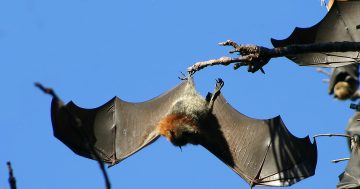
Wetlands treasurer Bill Wilkes near the plinth retrieved from Sydney’s Central Station and acquired from Crookwell stone mason Brian Doyle for $1250 in 2017. Brian delivered the stone and affixed it to concrete. Photo: John Thistleton.
An enormous sandstone plinth rescued from the arches at Sydney’s Central Station sits at the entrance of Goulburn Wetlands, a silent reminder of the resourcefulness that created this flourishing native shelter.
The repurposed brick pit is well recorded, and some of the bricks are preserved in situ in line with archaeological recommendations, but the massive sandstone plinth’s origin could fade from memory.
Wetlands treasurer Bill Wilkes recalls the foundation members looking for something on which to mount a plaque and striking up a conversation about it with Crookwell stone mason Brian Doyle who said he might have just what was needed, after completing a major project repairing and replacing sandstone at Central Station.
After inspecting the plinth at Brian’s stone yard at Crookwell, Bill said it was perfect.
“If I went to Central Station I would be able to pick out which one it replaced because it was more or less a cornerstone, right at the top of the vertical where two arches come in,” Bill said.
“It must have been starting to erode, which is the problem with sandstone. If it’s the cornerstone of two arches it needs to be pretty well up to scratch.”
Today, native shrubs surrounding the plinth are bursting into colour, abuzz with bees and birds for spring. Like the hefty Central Station plinth, once they were planted they were on their own and received no special treatment.

Volunteers take a break from weeding a river bank at the wetlands. From left are Frank Antram, Kristin Mbothu, Bill Wilkes, Jan McCarthy, Heather West and Ashlea Mahoney. Photo: John Thistleton.
“It’s survival of the fittest, but we have been astounded at the success rate,” says Friends of Goulburn Swamplands (FROGS) president Heather West. “We have a 90 per cent success rate with everything we plant, which is just terrific.”
Heather says the seeds for the native plants’ success were literally sown by Southern Tablelands branch of the Australian Plant Society, which collected seed from remnant bushland along riversides around Goulburn.
The branch’s president Jen Ashwell says most of the plants have adapted well, except some eucalypts along the Mulwaree River stretches, which struggled during flooding.
“It is knowing what to grow locally, getting local seeds rather than going to a shop and buying something that has been grown in the north of the state or seed from the north of the state, which is always a problem,” Jen said. “Whereas if you collect seeds from local trees the chances of survival are greater.”
Heather said FROGS let the Australian Plant Society know two years in advance what was needed, giving them time to source and propagate seeds into tube stock. They then followed the planting guide written by another founding member of the wetlands, Rodney Falconer.
“Right from the word go we weren’t just choosing natives and putting them in, we were choosing riverside natives endemic to the area long-term,” she said. Mulching and tree guards help moisture retention and stave off rabbits, whose numbers have declined thanks to volunteer Greg Warden’s expertise in poisoning active warrens.
Goulburn Field Naturalists Society member Ashlea Mahoney has taken over from Rodney Falconer overseeing the planting guide. Another volunteer with extensive plant knowledge, Pauline Huson, tends to two gardens with native plants that are not necessarily from the local region but survive in this climate. She chooses species for a variety of heights and colours at different times of the year and labels them with their scientific names.

Pauline Husen pruning a Lomandra ‘Lime Tuff’ on the ‘Banksia Embankment’, one of two gardens at either end of the wetlands that show species not endemic to Goulburn but suitable for local growing conditions. Photo: John Thistleton.
Over a decade of planting, a severe drought, flooding, then the ponds drying up completely in 2017 and 2018 have tested but not defeated the shrubs, trees and volunteers who tend to them each week. The helpers belong to several groups with overlapping aims, including the Australian Plant Society, Field Naturalists and The Goulburn Group, which gave the entire project a start as solid as a Central Station plinth.
On 21 October, the Goulburn Wetlands and Field Naturalists will again host a picnic for local environmental groups between 11 am and 2 pm, for groups including WIRES, Land for Wildlife, Goulburn District Beekeepers Club and the Australian Conservation Foundation.

The Goulburn Group’s Mhairi Fraser wrote a welcome to guests at the entrance plaque for the wetlands, asking them to tread lightly among the turtles, frogs and rare birds. photo: John Thistleton.
On 18 and 19 November Australian Plant Society NSW will be meeting in Goulburn and visiting the wetlands.
An ongoing challenge remains of controlling weeds, a tedious pastime that needs more volunteers. Each time the river floods a fresh batch of troublesome weeds from upstream take root in river banks and spread out.
If you would like to join the volunteers each Wednesday morning, visit the FROGS Facebook page.









